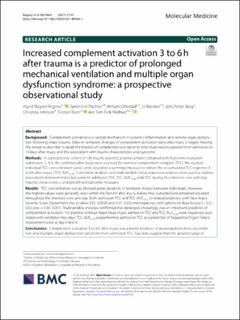| dc.contributor.author | Rognes, Ingrid Nygren | |
| dc.contributor.author | Pischke, Søren Erik | |
| dc.contributor.author | Ottestad, William | |
| dc.contributor.author | Røislien, Jo | |
| dc.contributor.author | Berg, Jens Petter | |
| dc.contributor.author | Johnson, Christina | |
| dc.contributor.author | Eken, Torsten | |
| dc.contributor.author | Mollnes, Tom Eirik | |
| dc.date.accessioned | 2022-01-14T09:48:20Z | |
| dc.date.available | 2022-01-14T09:48:20Z | |
| dc.date.created | 2021-07-09T19:19:48Z | |
| dc.date.issued | 2021-04 | |
| dc.identifier.citation | Rognes, I.N., Pischke, S.E., Ottestad, W., Røislien, J., Berg, J.P., Johnson, C., Eken, T., Mollnes, T.E. (2021) Increased complement activation 3 to 6 h after trauma is a predictor of prolonged mechanical ventilation and multiple organ dysfunction syndrome: a prospective observational study. Molecular medicine, 27 (1), 1-13. | en_US |
| dc.identifier.issn | 1076-1551 | |
| dc.identifier.uri | https://hdl.handle.net/11250/2837413 | |
| dc.description.abstract | Background
Complement activation is a central mechanism in systemic inflammation and remote organ dysfunction following major trauma. Data on temporal changes of complement activation early after injury is largely missing. We aimed to describe in detail the kinetics of complement activation in individual trauma patients from admission to 10 days after injury, and the association with trauma characteristics and outcome.
Methods
In a prospective cohort of 136 trauma patients, plasma samples obtained with high time resolution (admission, 2, 4, 6, 8 h, and thereafter daily) were assessed for terminal complement complex (TCC). We studied individual TCC concentration curves and calculated a summary measure to obtain the accumulated TCC response 3 to 6 h after injury (TCC-AUC3–6). Correlation analyses and multivariable linear regression analyses were used to explore associations between individual patients’ admission TCC, TCC-AUC3–6, daily TCC during the intensive care unit stay, trauma characteristics, and predefined outcome measures.
Results
TCC concentration curves showed great variability in temporal shapes between individuals. However, the highest values were generally seen within the first 6 h after injury, before they subsided and remained elevated throughout the intensive care unit stay. Both admission TCC and TCC-AUC3–6 correlated positively with New Injury Severity Score (Spearman’s rho, p-value 0.31, 0.0003 and 0.21, 0.02) and negatively with admission Base Excess (− 0.21, 0.02 and − 0.30, 0.001). Multivariable analyses confirmed that deranged physiology was an important predictor of complement activation. For patients without major head injury, admission TCC and TCC-AUC3–6 were negatively associated with ventilator-free days. TCC-AUC3–6 outperformed admission TCC as a predictor of Sequential Organ Failure Assessment score at day 0 and 4.
Conclusions
Complement activation 3 to 6 h after injury was a better predictor of prolonged mechanical ventilation and multiple organ dysfunction syndrome than admission TCC. Our data suggest that the greatest surge of complement activation is found within the first 6 h after injury, and we argue that this time period should be in focus in the design of future experimental studies and clinical trials using complement inhibitors. | en_US |
| dc.language.iso | eng | en_US |
| dc.publisher | BioMed Central | en_US |
| dc.rights | Navngivelse 4.0 Internasjonal | * |
| dc.rights.uri | http://creativecommons.org/licenses/by/4.0/deed.no | * |
| dc.subject | helsefag | en_US |
| dc.subject | traumepasienter | en_US |
| dc.title | Increased complement activation 3 to 6 h after trauma is a predictor of prolonged mechanical ventilation and multiple organ dysfunction syndrome: a prospective observational study | en_US |
| dc.type | Peer reviewed | en_US |
| dc.type | Journal article | en_US |
| dc.description.version | publishedVersion | en_US |
| dc.rights.holder | © The Author(s) 2021. | en_US |
| dc.subject.nsi | VDP::Medisinske Fag: 700::Klinisk medisinske fag: 750::Traumatologi: 783 | en_US |
| dc.source.volume | 27 | en_US |
| dc.source.journal | Molecular medicine (Cambridge, Mass. Print) | en_US |
| dc.source.issue | 1 | en_US |
| dc.identifier.doi | 10.1186/s10020-021-00286-3 | |
| dc.identifier.cristin | 1921263 | |
| dc.source.articlenumber | 35 (2021) | en_US |
| cristin.ispublished | true | |
| cristin.fulltext | original | |
| cristin.qualitycode | 1 | |

